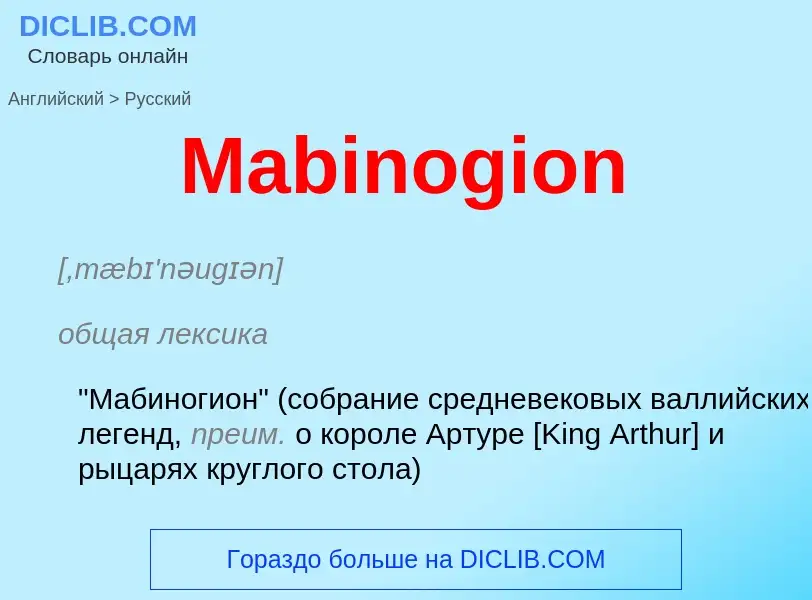Translation and analysis of words by ChatGPT artificial intelligence
On this page you can get a detailed analysis of a word or phrase, produced by the best artificial intelligence technology to date:
- how the word is used
- frequency of use
- it is used more often in oral or written speech
- word translation options
- usage examples (several phrases with translation)
- etymology
Mabinogion - translation to russian
[,mæbɪ'nəugɪən]
общая лексика
"Мабиногион" (собрание средневековых валлийских легенд, преим. о короле Артуре [King Arthur] и рыцарях круглого стола)
от валл. юношеские произведения
синоним
Wikipedia

The Mabinogion (Welsh pronunciation: [mabɪˈnɔɡjɔn] (listen)) are the earliest Welsh prose stories, and belong to the Matter of Britain. The stories were compiled in Middle Welsh in the 12th–13th centuries from earlier oral traditions. There are two main source manuscripts, created c. 1350–1410, as well as a few earlier fragments. The title covers a collection of eleven prose stories of widely different types, offering drama, philosophy, romance, tragedy, fantasy and humour, and created by various narrators over time. There is a classic hero quest, "Culhwch and Olwen"; a historic legend in "Lludd and Llefelys," complete with glimpses of a far off age; and other tales portray a very different King Arthur from the later popular versions. The highly sophisticated complexity of the Four Branches of the Mabinogi defies categorisation. The stories are so diverse that it has been argued that they are not even a true collection.
Scholars from the 18th century to the 1970s predominantly viewed the tales as fragmentary pre-Christian Celtic mythology, or in terms of international folklore. There are certainly components of pre-Christian Celtic mythology and folklore, but since the 1970s an understanding of the integrity of the tales has developed, with investigation of their plot structures, characterisation, and language styles. They are now seen as a sophisticated narrative tradition, both oral and written, with ancestral construction from oral storytelling, and overlay from Anglo-French influences.
The first modern publications were English translations by William Owen Pughe of several tales in journals in 1795, 1821, and 1829. However it was Lady Charlotte Guest in 1838–45 who first published the full collection, bilingually in Welsh and English. She is often assumed to be responsible for the name "Mabinogion", but this was already in standard use in the 18th century. Indeed, as early as 1632 the lexicographer John Davies quotes a sentence from Math fab Mathonwy with the notation "Mabin" in his Antiquae linguae Britannicae ... dictionarium duplex, article "Hob". The later Guest translation of 1877 in one volume has been widely influential and remains actively read today. The most recent translation is a compact version by Sioned Davies. John Bollard has published a series of volumes with his own translation, with copious photography of the sites in the stories. The tales continue to inspire new fiction, dramatic retellings, visual artwork, and research.


![Christopher Williams]], (1910) Christopher Williams]], (1910)](https://commons.wikimedia.org/wiki/Special:FilePath/Ceridwen.jpg?width=200)
![''The Panel of the Mabinogi'' (watercolour and gouache on silk) by [[George Sheringham]] (1884–1937) ''The Panel of the Mabinogi'' (watercolour and gouache on silk) by [[George Sheringham]] (1884–1937)](https://commons.wikimedia.org/wiki/Special:FilePath/George Sheringham - The Panel of the Mabinogi - ref 10525.jpg?width=200)
![The opening few lines of the Mabinogi, from the ''[[Red Book of Hergest]]'', scanned by the Bodleian Library The opening few lines of the Mabinogi, from the ''[[Red Book of Hergest]]'', scanned by the Bodleian Library](https://commons.wikimedia.org/wiki/Special:FilePath/Jesus-College-MS-111 00349 175r (cropped).jpg?width=200)
